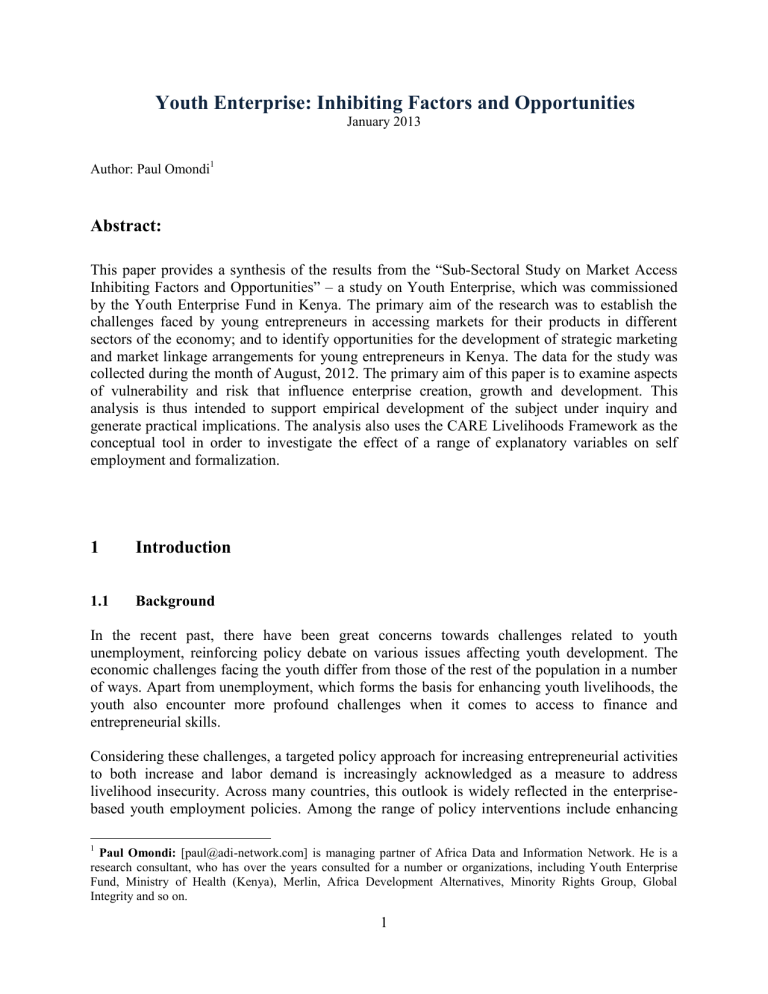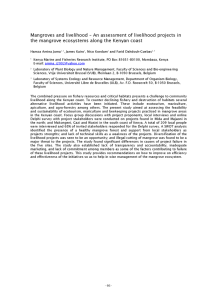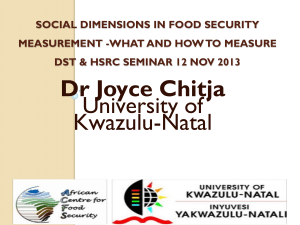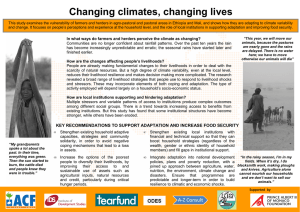
Youth Enterprise: Inhibiting Factors and Opportunities January 2013 Author: Paul Omondi1 Abstract: This paper provides a synthesis of the results from the “Sub-Sectoral Study on Market Access Inhibiting Factors and Opportunities” – a study on Youth Enterprise, which was commissioned by the Youth Enterprise Fund in Kenya. The primary aim of the research was to establish the challenges faced by young entrepreneurs in accessing markets for their products in different sectors of the economy; and to identify opportunities for the development of strategic marketing and market linkage arrangements for young entrepreneurs in Kenya. The data for the study was collected during the month of August, 2012. The primary aim of this paper is to examine aspects of vulnerability and risk that influence enterprise creation, growth and development. This analysis is thus intended to support empirical development of the subject under inquiry and generate practical implications. The analysis also uses the CARE Livelihoods Framework as the conceptual tool in order to investigate the effect of a range of explanatory variables on self employment and formalization. 1 Introduction 1.1 Background In the recent past, there have been great concerns towards challenges related to youth unemployment, reinforcing policy debate on various issues affecting youth development. The economic challenges facing the youth differ from those of the rest of the population in a number of ways. Apart from unemployment, which forms the basis for enhancing youth livelihoods, the youth also encounter more profound challenges when it comes to access to finance and entrepreneurial skills. Considering these challenges, a targeted policy approach for increasing entrepreneurial activities to both increase and labor demand is increasingly acknowledged as a measure to address livelihood insecurity. Across many countries, this outlook is widely reflected in the enterprisebased youth employment policies. Among the range of policy interventions include enhancing 1 Paul Omondi: [paul@adi-network.com] is managing partner of Africa Data and Information Network. He is a research consultant, who has over the years consulted for a number or organizations, including Youth Enterprise Fund, Ministry of Health (Kenya), Merlin, Africa Development Alternatives, Minority Rights Group, Global Integrity and so on. 1 greater access to credit facilities. In Kenya, the flagship initiative is the Youth Enterprise Development Fund and Women Enterprise Fund. As a result, micro and small enterprises (MSEs) have achieved the highest growth in employment levels during the past two decades. According to the Kenya Economic Report (2009), MSEs recorded a positive growth of about 3 per cent in the period 1990-2005 of Kenya’s average annual labour force, accounting for 87 per cent of all the new jobs created and employing 77 per cent of the total number of employees in the country. Nonetheless, even with this great potential to increase employment in these contexts, MSEs continue to face a number of challenges, many of these preventing those business ventures that have the potential to grow and develop more stable structures from formalizing. 1.2 The Problem Kenya has an overwhelmingly large young population, with children and young people under the age of 35 years accounting for 78% of the total population. As the country gears towards Vision 2030, the Kenyan youth faces important challenges, particularly in the economic context of livelihoods. A large population of young people is without work and many more are engaged in short-term, low-paid jobs or in the informal economy. Kenya shows a disproportionately high rate of youth unemployment as compared with adult unemployment rates. The youth, those aged 18 to 34, represent 43% of the working age population in Kenya, and these youth constitute 70% of total unemployment. According to the Economic Survey figures (Kenya National Bureau of Statistics, 2008), approximately 800,000 youth from primary, secondary and high learning institutions enter the job market annually, while only about 50,000 get employment into formal sector. With high expectations for employment, the issue of how to generate employment remains important. It is on this account that, macroeconomic policies have been formulated, within the framework of youth development initiatives. These put micro and small enterprise development at the centre stage, which include a range of measures to improve the access of young people to vocational training. The importance of enterprise development are articulated in various policy documents, the recent ones being the 2005 employment targeted poverty reduction strategic paper and government sessional papers including the 2003a Sessional Paper on the Development of micro and small enterprises for employment creation and poverty reduction, and the 2003b Economic recovery strategy for wealth and employment creation. The strategies to increase opportunities for the youth have been operationalized in the “Marshal Plan” for youth unemployment, which emphasized the importance of a coordinated and multi-sectoral approach to address the problem of youth unemployment. In 2006, the Youth Enterprise Development Fund (YEDF) was conceived as a strategic move towards addressing youth unemployment in Kenya through enterprise development. But even with strategies for accelerated youth development in place, it is apparent that economic development of the youth has been slower than expected, leading to continuing gross socioeconomic disparities between the youth and the rest of population. Whereas the underlying premise is that economic development and poverty reduction can be achieved by enhancing 2 access to financial resources, entrepreneurship policies should focus on expanding livelihoods. Thus, in this research, we make the case for broadening the scope of livelihood interventions to take account of the various kinds of resources upon which the youth draw on for their livelihoods. Using livelihoods approach, this research explores the relationship between entrepreneurship and livelihood, and how these are likely to impact on entrepreneurial prospects. 1.3 Research Objectives and Questions The broad objective of this research is to investigate on factors that affect youth enterprise in Kenya. In investigating the experiences of youth entrepreneurs, this study examines aspects of vulnerability and risk that influence enterprise creation, growth and development. The research is thus intended to support empirical development of the subject under inquiry and generate practical implications. The following comprised the research questions: 1. 2. 3. 4. 5. 1.4 Does unemployment predict self-employment? Does vocational training predict self employment? What impact does business skills have on attitude towards formalization? Do infrastructure conditions influence position on formalization? Do socio-cultural dynamics, in terms of informal social relations and associations influence attitude towards formalization? Structure of this Paper The rest of this paper is organised as follows. Section 2 provides a conceptual overview. The paper begins by clarifying the links between the concepts of livelihood context, livelihood strategies and livelihoods outcomes. This section then follows with operational definition of the variables, which the leads to hypotheses. This section therefore mainly involves literature review relevant to the subject. Section 3 informs the design of the study and procedures employed for the analysis. Section 4 summarizes the results, providing a detailed discussion of the results. Section 5 concludes with strategies for strengthening youth entrepreneurship development. 2 Conceptual Framework 2.1 Concept and clarification of livelihoods This study uses the CARE Livelihoods Framework as the conceptual tool for understanding youth entrepreneurship. The relationship between entrepreneurship and livelihoods is complex and is influenced by a wide range of factors. In the Chambers and Conway (1992) definition, ‘livelihood’ “comprises the capabilities, assets (stores, resources, claims and access) and activities required for a means of living: a livelihood is sustainable which can cope with and recover from stress and shocks, maintain or enhance its capabilities and assets, and provide 3 sustainable livelihood opportunities for the next generation; and which contributes net benefits to other livelihoods at the local and global levels and in the long and short term.” Mearn (n.d.) increases our understanding of the value of the Sustainable Livelihood approach by expounding on the following aspects regarding sustainable livelihood: a) it captures the importance of the micro-level institutional context in mediating the impacts of the macro-level economic and institutional environment on the well-being of particular individuals and social groups; b) it situates assets in their broader context, focusing on their contribution to realizing the livelihood outcomes of the poor; and c) it encapsulates the dynamics and multiple dimensions of poverty, ill-being and deprivation (both material dimensions such as low income/ consumption levels, and non-material dimensions such as powerlessness and social exclusion). According to Chambers and Conway (1992) "a livelihood comprises the capabilities, assets and activities required for a means of living. A livelihood is sustainable when it can cope with and recover from stresses and shocks and maintain or enhance its capabilities and assets both now and in the future, while not undermining the natural resource base." The CARE framework puts particular emphasis on strengthening the capability of poor people to enable them to take initiatives to secure their own livelihoods. Central to this approach is particular emphasis on the dimension of “empowerment.” Two levels of empowerment are distinguished to that regard: First is personal empowerment, which refers to enhancing people’s confidence and skills (i.e. their human capital) to overcome constraints, principally in the economic sphere. Second is Social empowerment, which refers to the establishment and/or strengthening of existing, representative, community-based organizations to build up the capacity for community members to plan and implement priority development activities which emerge from participatory needs assessments, and in so doing, to provide communities with the means to develop their own principles and structures of democratic representation and governance (Drinkwater and Rusinow in Krantz, 2001). The defining aspects of the CARE framework underpin three fundamental attributes needed to enhance sustainable livelihood: 1) The possession of human capabilities; 2) Access to tangible and intangible assets; and 3) The existence of economic activities. By and large, the framework underlines interrelationships between these three aspects, and in this way, either enhance or constrain people's ability to make a living in a sustainable manner. A schematic representation of the conceptual framework underlying the key dimensions of livelihood and on how they interact is shown in Figure 1, with a detailed description of each dimension provided below. 4 Figure 1: Livelihoods framework for youth entrepreneurship Assets Human capital (Livelihood capabilities) Vulnerability and poverty risk Education status Production and income activities Social capital (Claims and access) Youth Economic capital (Stores and resources) Consumption activities Livelihood security Level of income Income stability Vocational training Entrepreneurship Self employment Business formalization Livelihood Contexts Livelihood strategies Livelihood outcomes Source: Adapted with slight modification from Care Livelihoods Framework 2.2 Livelihood Contexts A concept closely related to livelihood contexts is that of vulnerability. The vulnerability context forms the external environment in which people exist and gain importance through direct impacts upon people’s asset status (Devereux in Kollmair and Gamper 2002). It comprises Trends (i.e. demographic trends; resource trends; trends in governance), Shocks (i.e. human, livestock or crop health shocks; natural hazards, like floods or earthquakes; economic shocks; conflicts in form of national or international wars) and Seasonality (i.e. seasonality of prices, products or employment opportunities and represents the part of the framework that lies furthest outside stakeholder’s control (Kollmair and Gamper 2002). People’s livelihoods and the wider 5 availability of assets are fundamentally affected by critical trends as well as by shocks and seasonality, over which they have limited or no control (DFID, 1999). In the context of this study, vulnerability and poverty are seen as inextricably linked. Poverty refers mainly to a lack of material or monetary resources (UNDP, 2006). On the other hand, vulnerability is defined as the probability or risk today of being in poverty or to fall into deeper poverty in the future (The World Bank, 2011). Whereas most literature generally make a distinction between vulnerability and poverty, the link between the two is also underlined on the basis that poverty increase vulnerability. On this basis, vulnerability may influence household behavior and coping strategies and is thus an important consideration for poverty reduction policies (Ibid). Clearly, the youth are exposed more to the risks of poverty than other age groups. Important variables of youth poverty relates to employment and wealth status. As noted, generally speaking, young people are in a less favourable social and economic position, since they do not possess property (property, savings, shares) and have more difficulty finding employment or a place to live (UNDP, 2006). In general the findings of previous research as reported in the ILO (2010) study reports, show that the youth are “disproportionately susceptible to poverty, reinforcing the notion that youth are not just disadvantaged in terms of accessing work, but also in finding productive work that provides sufficient income to escape poverty.” Considered in this manner, income level and stability remain the central and defining characteristics of vulnerability, and can have positive or negative influences on the livelihood strategies that the youth pursue. The model, as employed in this study, draws attention to entrepreneurship as the means through which the youth develop their underlying resources and capacities to cope with the challenges they encounter. The assumption is that the youth would generally go into self emplyment by default. In this way, the youth build their livelihood assets to meet their needs on a sustained basis. 2.3 Livelihood Strategies According to Kollmair and Gamper (2002) the livelihood strategies comprise; “the range of combination of activities and choices that people undertake in order to achieve their livelihood goals.” They constitute a range of processing and exchange activities designed to build asset bases and access to goods and services for consumption. The analysis of livelihoods using the CARE Livelihoods Framework places emphasis on the livelihood assets or capitals to which people have access, and how they draw on their livelihood assets or capital in different arrangements to achieve desired livelihood outcomes. Bebbington (1999) describes the portfolio of these livelihood assets as "not simply resources that people use in building livelihoods: they are assets that give them the capability to be and act." The CARE framework focuses on three clusters of livelihood assets, namely: Human capital Social capital, and Economic capital. Adopting the characterization of “livelihood resources” in the IDS framework (Scoones, 1998), the three assets can be described as follows: 6 i. ii. iii. Human capital – includes the skills, knowledge, ability to labour and good health and physical capability important for the successful pursuit of different livelihood strategies. Social capital – includes the social resources (networks, social claims, social relations, affiliations, associations) upon which people draw when pursuing different livelihood strategies requiring co-ordinated actions Economic or financial capital – includes the capital base (cash, credit/debt, savings, and other economic assets, including basic infrastructure and production equipment and technologies) which are essential for the pursuit of any livelihood strategy. Drawing from the broader literature on livelihood framework, it is necessary to acknowledge that the livelihood strategies that people pursue to achieve their objectives are fundamentally influenced by both the context of the environment in which they exist and livelihood assets that they have access to. Focusing on the interconnections between these aspects of livelihood, Ellis (1999) postulates that, “In pursuing livelihood strategies composed of a range of activities, both the access to assets and the use to which they can be put are mediated by social factors (social relations, institutions, organisations) and by exogenous trends (e.g. economic trends) and shocks (drought, disease, floods, pests).” In the context of the youth, self employment remains essential part of their livelihood strategy to improve circumstances in the long term. Sustained periods of unemployment naturally motivate the youth to seek alternatives to wage employment, which can include various types of production and income-generating activities. 2.4 Livelihood Outcomes Another important dimension is that of livelihood outcomes. Livelihood outcomes are the goals to which people aspire, the results of pursuing their livelihood strategies, such as increased income, reduced vulnerability, increased well-being, improved food security, and more sustainable use of natural resources (Alinovi, D’Errico, Mane, and Romano, 2010). These outcomes are determined by the interaction of the broader livelihoods systems on which people operate, including contexts, assets and strategies. The notion of livelihoods outcomes are important because they help the analyst to understand the results of peoples’ livelihoods strategies in a particular context, why people pursue particular strategies and what their priorities are, and how people are likely to respond to new opportunities or constraints (Ibid). Under economic perspective, an important aspect of the livelihood outcomes is the effects on livelihood security, defined as adequate and sustainable access to income and resources, notably to address food security, well-being, and sustainable resource management. In relation to youth entrepreneurship, these outcomes could be reflected in the level in the income level and income stability. 7 2.5 Hypotheses and Variables 2.5.1 Research Variables Taking into consideration the conceptual model, the goal of this analysis is two-fold. First, is to examine self employment as a livelihood choice made by unemployed youth, to provide support to the argument that self employment is the means through which the youth cope with the livelihood challenges they encounter. Second, is to explore the interplay of self employment and livelihood assets in the context of business formalization. Formality has been identified as an important variable of livelihood outcomes. This is based on the premise that the more formal the business activity, the higher the income and stability of a business activity. This perspective is supported by the observation that businesses will embrace formality up to the point where the marginal costs of so doing are less than the benefits they will gain (Development Alternatives and Bannock Consulting Ltd, 2005). On the contrary, informality “is characterized by low-pay and low job security among its employees and large-extent informality in an economy is an indicator of corruption, poor regulatory, financial and labor market environment” (Kunt, 2008). On the basis of the conceptual model used in this study, the independent variables are constructed around the constructs of vulnerability and poverty risk on the one hand, namely: education status and vocational training; and on the other hand, constructs corresponding to the three assets portfolio, i.e. human, economic and social. In terms of the dependent variables, the measures are constituted around the constructs of entrepreneurship, namely: employment status and formality. The descriptions of these variables are given below: Independent variables Education status: The measures corresponded to the following six levels: no formal education, primary, secondary, tertiary, undergraduate and postgraduate. Vocational training: The measures were operationalized on the basis of whether the respondent had training or not. Hence, vocational training was measured as follows: If the respondent has training = Yes; if the respondent has no training = No Livelihood assets: The measures for the three assets portfolio (human, economic and social) were operationalized through the use of four corresponding variables, namely: business skill, infrastructure, and socio-cultural dynamics. All the three variables were measured using a four point Likert scale, ranging from “Not a problem at all” to “Very Big problem.” Dependent variables Employment status: The measures corresponded to the following four options: self-employment, formal wage employment, both formal wage employment and self-employment and unemployed. For this study, unemployed were filtered out of the analysis, and accordingly, the variable measured as follows: if the respondent is either in self-employment or both in self-employment and formal wage employment = Yes; if the respondent is in formal wage employment only = No. 8 Formality: The measures were operationalized on the basis of the business registration status. Hence, formalization was measured as follows: If the business venture is registered = Yes; if business venture is not registered = No 2.5.2 Research Hypotheses The hypotheses highlighted in this document focus on the response (dependent) variables that have been identified in the model. These are discussed below: i) Education and self employment Formal education has been identified as an avenue to greater opportunities to participate in the formal wage sector. Conversely, therefore, fewer years of education is as a factor limiting access to wage employment. Additionally, it is also likely that workers with fewer years of education would receive lower incomes. Theoretical arguments have been constructed to explain the choice of self-employment. One such theory is the Disadvantage Theory, which is classified under what are referred to as the Sociological-Psychological Theories of self-employment. According to this preposition, individuals treat self-employment as a "survival strategy", rather than generator of ideas or source of higher income (Startienė, Remeikienė, and Dumčiuvienė, 2010). In view of this, the disadvantage theory states that workers with low labour market opportunities become self-employed more often, although as noted, this is driven by necessity rather than the opportunities presented in entrepreneurship. Correlating livelihood contexts and self employment, Light (in Startienė, Remeikienė, and Dumčiuvienė, 2010) identified unemployment, business cycles, poverty, discrimination and excessive urbanization, as barriers, which essentially had a positive effect on a person's determination to become self-employed person. The above argument drives the first hypothesis: H1: Higher level of education positively influence interest in self employment ii) Vocational training and self employment Vocational training is yet another aspect that may influence an individual’s choice of self employment to improve his/her circumstances in the long term. Vocational training is training for a specific career or trade, with a focus on practical applications of skills learned. In practice therefore, vocational training is well placed to provide a link between education and the working world (Doak, u.d). Although there appears to be little robust evidence on the link between vocational training and self employment, the vocational educators have come to recognize that starting a business is a natural outgrowth of vocational skills training (Ashmore, 1990). Alongside the same line of thought, Bronte-Tinkew, J. and Redd, Z (2001) posit that vocational programs can have positive influences on academic success as a result of “hands-on” experiences which help build self-esteem, feelings of selfefficacy, leadership skills, interactions with others, and promoting an overall decrease in problem behaviors. The above argument gives rise to the second hypothesis: H2: Vocational training improves the desirability for self employment 9 iii) Business skills and formalisation Lack of business skills has been identified as a key barrier to youth’s entrepreneurship. According to Ghai (in Chigunta et al., 2005), entrepreneurship among young people as is mired by a number of factors, including lack of skills, social capital, knowledge and experience which have lead to poor overall performance of youth enterprises. On this account, youth enterprise is highly vulnerable to failure (Entwistle, 2008). The research by Meager, Martin and Carta (2011) represent one of the most important sources for statistical analysis of the links between self employment and business skills. The evidence suggests that a wide range the generic competences are important for success in self-employment over and above any occupational skills which may be required. These include: the individuals values, beliefs and attitudes; ‘soft’ skills including interpersonal, communication and networking skills; realistic awareness of the risks and benefits of self-employment; functional business skills; and relevant business knowledge. Further, the research underscores the importance of prior work experience, particularly if it includes previous spells of self-employment, contributes to success in selfemployment. Highlighting the relationship between business skills and formalization, Pugh et al. (in Karim, 2003), drawing from empirical evidence, posits that a firm's growth also means a better structuring of its activities. Such bureaucratisation is expressed in more extensive standardization, an increase in formalization and higher specialization. On the basis of the above argument, the following hypothesis has been formulated: H3: Business skills positively influence attitude towards formalisation iv) Infrastructure and formalisation The role of infrastructure on development of micro and small enterprise covers large terrain of literature and research concerned with entrepreneurship. Muteta, et.al. (1998) make reference to two basic types of infrastructure: first, social infrastructure, which covers education and health telecommunications, piped water supply, sanitation and sewerage, solid waste collection and disposal, and piped gas), public works (e.g. roads and dam and canal works) and transport (e.g. urban and interurban railways, urban transport, ports and waterways, and airports). From the point of view of this study, the focus is on the latter. Research demonstrates the role of infrastructure in essential for formalization of informal enterprises. This view compares well with the research by Mutea, et. al (Ibid), which looked at the impact of infrastructure on informal sector enterprises. They observed that medium-sized firms were “evolving” enterprises (i.e. those whose production and clients are expanding) that were gradually becoming infrastructureintensive (e.g. relying heavily on electricity to run machinery). For that reason, the absence of infrastructure would stifle the growth of such “evolving” enterprises; infrastructure provision on the other hand would promote their growth and integration into the formal economy (Ibid). Hence, this leads to the following hypothesis: H4: Presence of infrastructure positively influence position towards formalisation v) Socio-cultural dynamics and formalisation One critical factor, albeit unexplored, is the impact on and influence socio-cultural dynamics on development of micro and small enterprise. In some countries, enterprises operating in the 10 informal sector experience resistance to formalization due to socio-cultural factors. According to Portes and Haller (in Development Alternatives and Bannock Consulting Ltd, 2005), by and large, this is due to strong networks of trust and interdependence (Portes and Haller, 2002). Within the context of a strong cultural environment like Africa, the "African experience" is conceptually useful for better understanding the socio-cultural dynamic in the organization of the informal sector. Informality pervades several spheres of society and markets and can therefore be viewed as a well-integrated system. This is reflected in eating habits, social relations, dress codes, life-long work versus formal employment. Indigenous foodstuffs constitute an important dimension of the informal economy. Therefore the informal economy is attractive because it mimics life-long work, reflecting human beings’ transient life cycles (Kinyanjui, 2010). Thus, according to Kinyanjui, informal social relations and associations is one way through which the informal economy sustains itself and engages with markets and society. This view resonates well with that found in the report prepared by Development Alternatives and Bannock Consulting Ltd (2005), who observe that, when an informal entrepreneur has a history of successful trade with other informal entrepreneurs in the same social group, the motivation to formalize can be lacking. H5: Environment of strong socio-cultural dynamics negatively influence attitude towards formalisation 3 Research Methodology This study employed a quantitative methodology approach, which covered a nationally representative sample of the youth population in Kenya (18 to 34 years) derived from the latest National Population and Housing Census. The survey sample constituted 5000 respondents. To ensure that the sample is representative, “disproportionate stratified sampling” design was employed. The goal was to allow for a minimum sample of 80 for each of the 47 counties in Kenya in order to minimize the variability within each stratum and on the other hand maximize the diversities between the strata. In drawing the sample, the target population was stratified into geographical sub-groups, using the counties as the stratification variable. Following, the method of “optimal allocation” was used to distribute the sample across the counties, taking into consideration the population and variance among the respective sampling units. To that regard, a four-cluster distribution scheme used was employed as follows: Cluster 1 county (only Nairobi - population above 1 million) received a sample of 400. Cluster 2 counties (population of 0.5 to 1 million) received a sample of 120. Cluster 3 counties (population of 0.25 to 0.5 million) were accorded a sample of 100. Cluster 4 counties (population below 0.25 million) were accorded a sample of 80. This is disproportionate distribution was done deliberately so as to ensure that sufficient sample coverage for each county, taking cognizance that a blanket Probability Proportionate to Size (PPS) distribution of may not have yield a sample big enough to detect reasonable sub-sector 11 economic activities at these domains. As such the sample was subjected to post-stratification weighting to correct this imbalance. Data was collected from the respondents through face to face interviews at the household level. 3.1 Procedure The Statistical Products and Services Solution (SPSS) was used to analyse the data of the total achieved sample (N=4887). The data includes a wide range of business and individual level characteristics. The unit of analysis is the individual. The conceptual model in this study focuses on two dimensions of entrepreneurship, namely: self employment and formalization. Thus, in order to answer the five research questions delineated, it is necessary to establish two levels of analysis. The first level assesses the level of self employment, therefore the analysis is based on those who described their employment status as: self employed, employed or both self employed and employed (N=4399). Essentially, the analysis therefore filters out unemployed. The second level assesses business characteristics in terms of formality. The aim is to establish if there is a positive relationship between the three independent variables of livelihood assets and formality. Initially based on a four-point scale (1=not at all a problem; 2=small problem; 3=fairly big problem and 4=very big problem), the response variables are condensed into two sets of binary variables: “not at all/small problem” and “very/fairly big problem.” Here, the analysis is filtered to reflect only those involved in business venture (N=4135). A descriptive analysis has been performed to determine the average score and the statistical significance of the variance of sub-sample means. Given that are nominal variables are used, Pearson Chi square statistic is performed to check assess the statistical significance of the variance of sub-sample means. By statistical convention, P-value of 0.05 is taken to be significant, indicating association between the indicator and the specified variables. 4 Results and Discussion Table 1 shows the descriptive statistics of the variables analyzed for self employment. In the context of employment, the frequency of mention for “self employed” was 84%, followed by 10% that reported “both self employed and employed.” Thus, taken together, the results suggest substantially high levels of youth participation in self employment. Education status and self employment: In terms of education status, the results show that, among those in self employment, the percentages are decidedly higher for those with no formal education and primary education (depicting 91% and 92% respectively). Those with secondary and tertiary education depict 85% and 74% respectively. Conversely, those with undergraduate and postgraduate education depict 66% and 56% respectively. The Pearson Chi-Square statistic 12 value is: (χ²=213.40, df = 10, p=0.00). Hence, with significance value of 0.00, which is below the alpha level (0.05), the results suggest that a statistical significant relationship exists between education status and self employment. The results of the test therefore support hypothesis 1. Vocational training and employment: In the context of vocation training, the results show that, among those in self employment, the percentages are slightly higher for those who have not received training. The Pearson Chi-Square statistic value is: (χ²=37.45, df = 2, p=0.00). With a significance of 0.00, there is evidence to infer a relationship between vocational training and self employment, apparently, with lack of vocational training likely to improve the desirability for self employment. Hence, the results of the test support hypothesis 2. Table 1: Chi Square test results for self employment Criteria Number self employed Education status No formal education Primary Secondary Tertiary college Undergraduate Postgraduate Vocational training Has received training Has not received training % self employed 131 91 1184 92 1584 606 85 74 145 40 66 56 960 83 2544 86 χ² P-value 231.34 0.00 37.45 0.00 Table 2 shows the descriptive statistics of the variables analyzed for formality. Considered from a broad perspective, there is relatively higher inclination for informality, with 69% of the participants mentioning that they operated without any formal registration. Conversely, roughly one-third (31%) operated under registration. Of this proportion, the ones having the status of a limited company constituted a paltry 1% of the sample. Business skills and formality: In considering the relationship between business skills and formalization, the Pearson Chi-Square statistic value is: (χ²=42.37, df = 1, p=0.00). With significance value of 0.00, which is below the alpha level (0.05), the test confirms that there is association between business skills and attitude towards formalization. Therefore results of the test support hypothesis 3. Infrastructure and formality: In respect to infrastructure, the results are observed in the following Pearson Chi-Square statistic results: (χ²=1.07, df = 1, p=0.30). The significance value 13 of 0.30 is above the alpha level (0.05), essentially confirming that the hypothesized relationship between infrastructure and formalization. On this account, thus, the hypothesis 4 is not supported. Socio-cultural dynamics and formality: Finally, looking at the aspect of socio-cultural dynamics, the results are observed in the following Pearson Chi-Square statistic results: (χ²=0.06, df = 1, p=0.81). Similarly, the significance value of 0.81 is above the alpha level (0.05), confirming that there is no association between the two variables. Therefore hypothesis 5 is not supported. Table 2: Chi Square test results for attitude towards formality Criteria Number of businesses registered Business skills issues Small/Not at a problem at all Fairly/Very big problem 1018 331 Infrastructure issues Small/Not at a problem at all Fairly/Very big problem 763 583 Social-cultural dynamics Small/Not at a problem at all Fairly/Very big problem 178 1165 % of businesses registered χ² P-value 42.37 0.00 1.07 0.30 0.06 0.81 36 26 32 34 33 33 Discussion This paper employed a conceptual framework for sustainable livelihoods to investigate the effect of a range of explanatory variables on self employment and formalization. The findings indicated a positive relationship among the variables in respect to education and self employment. More years of formal education is seemingly a factor limiting the development of youth entrepreneurs. This attitude is likely to be the result of higher expectation or optimism that comes with higher level of education. Presumably, in view of anticipated initial low levels of income and uncertainty associated with new a business venture, important motivating factor for seeking employment rather than self employment is seemingly the desire to deriving maximum benefits from one’s human capital. In terms of vocational training and self employment, the results show that lack of vocational training likely to improve the desirability for self employment. This result is somewhat surprising, and contrary to the wider view that associates vocation training and entrepreneurship. 14 Again, it appears that the motivation comes from expectations or optimism that comes with the human capital. Turning to relation between business skills and formalization, the results revealed that business skills positively influence attitude towards formalization. Various literature show that many of the youth entrepreneurs lack necessary business skills, which is likely to be a factor impeding formalisation. On these grounds, the significance of possessing such skills is that they provide entrepreneurs with the ability to comply with the demands and expectation of the formal sector. When it comes to infrastructure and formalization, it is apparent that the various aspects of infrastructure do not necessary influence formalization. The results of this test appear to go against the importance given to infrastructure in literature. One argument why the results may not indicate an association between infrastructure and formalization is that the demand and supply linkages may be well entrenched hence minimizing the infrastructure requirements for individual enterprises. Finally, looking at socio-cultural dynamics and formalization, the results similarly show that socio-cultural dynamics do not necessary influence formalization. An argument why the results may be so is that, whereas informal social relations and associations are particularly important because they allow informal economy sustain relations and engage with markets and society, entrepreneurs reconfigure their relations with these networks in manner that may not necessarily impede formalization. 5. Conclusion and Implications The findings of this research show that, education and vocation training do not have a positive relation with individual’s decision to pursue entrepreneurial activities. Thus, important finding from this study is that, despite the contrary, human capital seemingly deters entrepreneurship. The argument in this research then is that despite the seemingly important role played by education and vocational training, there is a possibility that it does not provide a solution to Youth development in terms of entrepreneurship. The implications of having of having predominance of individuals with limited human capital, in this regard, operating pursuing entrepreneurial activities is that this can is likely to negatively impact on the quality of new ventures. On the other hand, what is outstanding in this study’s result is the impact significant explanatory influence business skills have on the attitude towards formalization. Again, the general predominance of individuals with limited human capital in entrepreneurship limits decisions to pursue formalization. Somewhat unexpectedly, the aspect of infrastructure did not show any association with formalization. The results obtained from this research do reveal some broad areas where a Sustainable Livelihoods approach could have implications on policy in terms of youth enterprise. Accordingly, youth development priorities should be based on the following: a) entrepreneurship education before the youth enter the labour force is an area that should be addressed in an effort 15 to promote self employment; b) education and training of small and medium business operators to make them better qualified; c) loan evaluation process that is devoted to assessing characteristics of the borrowers in terms of livelihood capabilities Limitations of Study This research takes into account three important limitations. One limitation is that the results may not represent of some key sectors such as manufacturing and mining, given that the survey employed purely random techniques. However, based on the fact that youth naturally have limited representation in these sectors, this does not render the data less credible. The second limitation is that the measures for the three set of livelihood assets portfolios were operationalized using single constructs, namely: business skills, infrastructure and socio-cultural dynamics. It would be useful for future studies to explore these dimensions using additional measures. Finally, the third limitation is that the study did not take into account important intervening variables of entrepreneurship, notably access to capital and credit. 16 References Alinovi, L., D’Errico, M., Mane, E., and Romano, D. (2010). LiveLihoods strategies and Household Resilience to Food insecurity: An Empirical Analysis to Kenya. European Research For Development [Conference paper], “Promoting Resilience Through Social Protection In Sub-Saharan Africa”, Dakar, Senegal, 28-30 June, 2010 Ashmore, M.C. (1990). Entrepreneurship in vocational education. In Entrepreneurship Education: Current Development, Future Promises. Westport Bebbington, Anthony (1999): Capitals and Capabilities: A Framework for Analyzing Peasant Viability, Rural Livelihoods and Poverty. World Development, 27(12): 2021-2044. Bronte-Tinkew, J. and Redd, Z (2001). Logic Models and Outcomes for Youth Entrepreneurship Programs. Report to the DC Children and Youth Investment Trust Corporation Chambers, R. And Conway, G. (1992:9) Sustainable Rural Livelihoods: Practical Concepts for the 21st Century. IDS Discussion Paper 296. Brighton: IDS Chigunta, F., J. Schnurr and V. Torres (2005) Being “Real” about Youth Entrepreneurship in Eastern and Southern Africa Implications for Adults, Institutionsand Sector Structures. SEED Working Paper No. 72. Series on Youth and Entrepreneurship International Labour Organization 2005 Development Alternatives and Bannock Consulting Ltd (2005). Removing Barriers to Formalization: The Case For Reform And Emerging Best Practice DFID (Department For International Development) (1999) Sustainable Livelihoods Guidance Sheets Doak, M. (u.d) Vocational Training - What Is Vocational Training?, Other Opportunities For Vocational Training, Conclusion http://careers.stateuniversity.com/pages/854/Vocational-Training.html Devereux, S (2001). “Livelihood Insecurity and Social Protection: A Re-emerging Issue in Rural Development”, Development Policy Review, 19:4 Drinkwater, Michael and Tamara Rusinow. Application of CARE’s Livelihoods Approach: Presentation for NRAC’ 99. Mimeo Ellis, F (1999). Rural Livelihood Diversity In Developing Countries: Evidence And Policy Implications. Overseas Development Institute, Number 40, April 1999 http://www.odi.org.uk/sites/odi.org.uk/files/odi-assets/publications-opinion-files/2881.pdf Entwistle R. (2008) Entrepreneurship and Youth: The Critical Role of the Christian Community in Development. A paper presented at the Baylor Symposium on Faith and Culture Bottom-up Approaches to Global Poverty: Appropriate Technology, Social Entrepreneurship, and the Church October 23-25th, 2008 Waco, Texas 17 ILO (2010).GLOBAL EMPLOYMENT TRENDS FOR YOUTH, Geneva PG 24 ILO (2005) Global employment trends for youth, Geneva, ILO. Karim, M (2003). Strategic entrepreneurship and managerial activities in SMEs. International Small Business Journal http://www.highbeam.com/doc/1G1-104210423.html Kollmair, M. and Gamper, St. 2002, The sustainable livelihoods approach, in paper for the integrated training course of CCR orth-South, Aeschiried, Geneva Krantz, L. (2001). The Sustainable Livelihood Approach to Poverty Reduction. SWEDISH INTERNATIONAL DEVELOPMENT COOPERATION AGENCY Kunt (2008 ) Entrepreneurship in Post-Conflict Transition: The Role of Informality and Access to Finance accessed on 15 September 2010. Kinyanjui, M (2010). Social Relations and Associations in the Informal Sector in Kenya. Social Policy and Development. Programme Paper Number 43 January 2010. United Nations Research Institute for Social Development Meager N, Martin R, Carta E (2011). Skills for Self-Employment. Evidence Report 31, UK Commission for Employment and Skills (UKCES), August 2011 http://www.employment-studies.co.uk/pubs/summary.php?id=ukceser31 Mearns, R. (n.d.) Environment Strategy: Note on natural and social capital linkages and the sustainable livelihoods approach http://wbln0018.worldbank.org/ESSD/NRMTG/Doclib.nsf/22dc293a0ad453638525681f0070ebb7/e4ca1 b75004233168525681f00725df2?OpenDocument Muteta, Ginette, Gideon K. Ngoi and Shaaban Sheuya. “Linkages between Infrastructure Development and Improved Productivity and Working Conditions in Informal Sector Enteprises.” International Labour Organization. March 1998. Startienė, G., Remeikienė, R., and Dumčiuvienė, D. (2010). Concept of Self-Employment. Economics and Management: 2010. 15 Scoones, I. (1998) ‘Sustainable Rural Livelihoods: A Framework for Analysis’, Working Paper 72, Brighton, UK: Institute for Development Studies UN (1987) Report of the World Commission on Environment and Development: Our Common Future (Brundtland Report) UN (1992) Report of The United Nations Conference on Environment and Development, Rio de Janeiro, 3-14 June 1992 UNDP (2006). Poverty, Unemployment and Social Exclusion, Hrvatska http://www.undp.hr/upload/file/104/52080/FILENAME/Poverty,%20Unemployment%20and%20Social% 20Exclusion.pdf 18 The World Bank (2011). Measuring Vulnerability. Poverty Reduction and Equity. Retrieved January 3, 2013. http://web.worldbank.org/WBSITE/EXTERNAL/TOPICS/EXTPOVERTY/EXTPA/0,,contentMDK:202 38993~menuPK:492141~pagePK:148956~piPK:216618~theSitePK:430367,00.html 19






